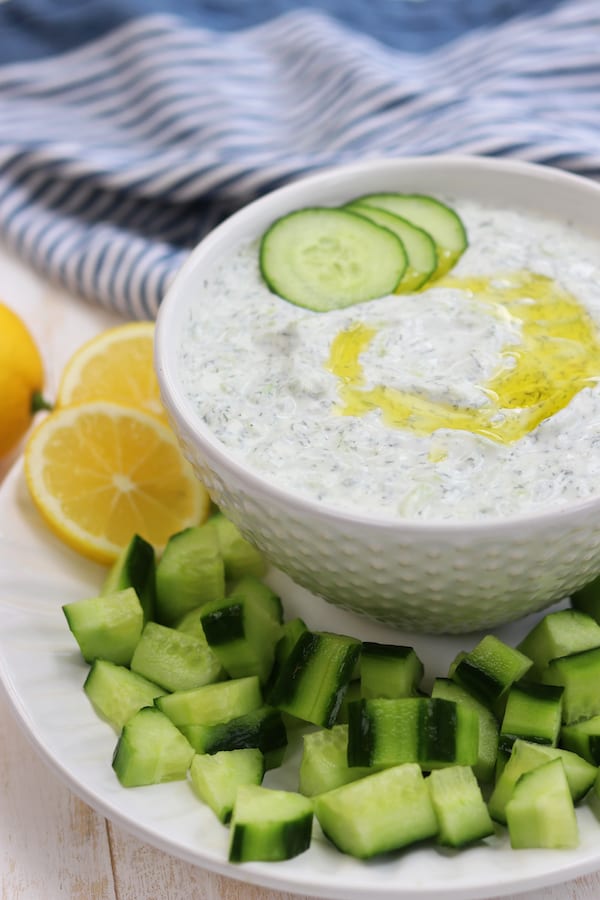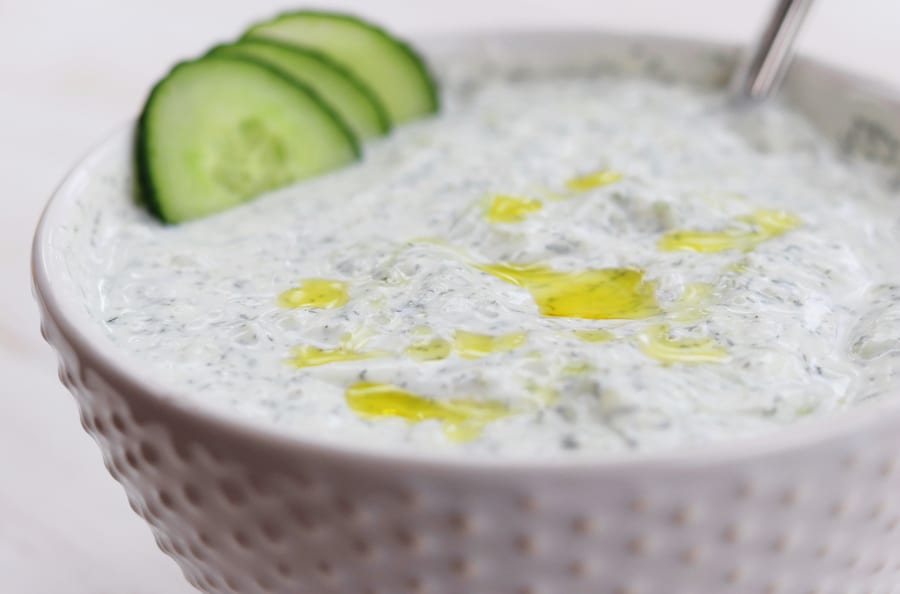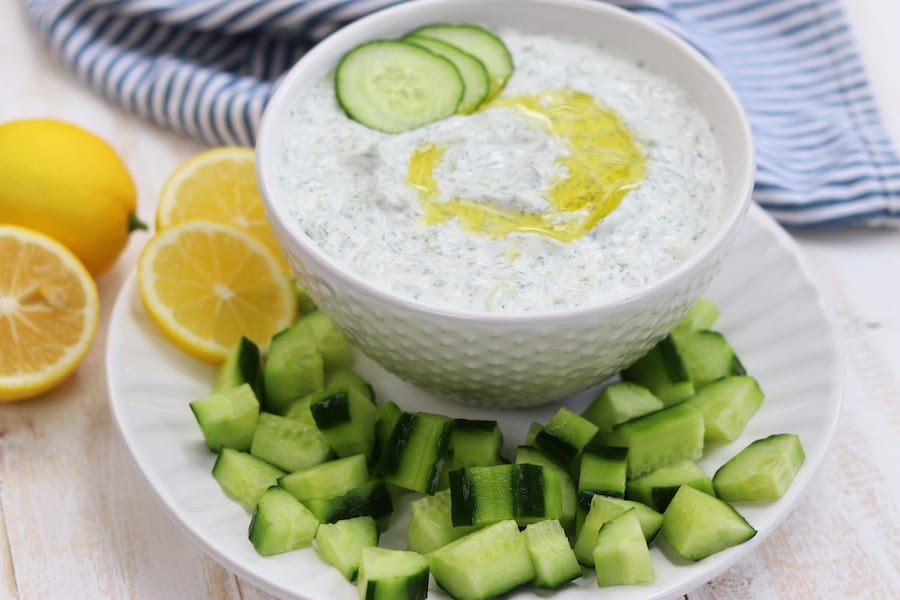Tzatziki Sauce
Creamy and refreshing, Tzatziki Sauce is the perfect Greek condiment with many types of meats or just simply as a dip.
This post may contain affiliate links which I earn a small portion in sales if a purchase is made. Rest assured though, it is never at any additional cost to you.
I wish I was a gardener, like an Ina Garten kind of gardener. You know the kind I mean, with the perfect rows of herbs. Her garden always looks so beautiful and oh, the luxury of walking out to the back yard and picking some fresh dill for recipes like this Tzatziki Sauce. It makes perfect sense that gardening and cooking should go hand and hand, right? Wrong!!! When God handed me the whole cooking talent and photography talent he left out the growing anything in dirt talent. I mean I can not grow anything in dirt. I kill cactus, the one thing that is supposed to be super easy to keep alive…hahahahaha… Not only do I kill everything that grows in dirt but I have a severe aversion to the creepy, crawling things living in that dirt. If only I had the same powers to not keep them alive. And don’t get me started on all the things buzzing around my head. I look like a crazed person to the tune of “GET IT OFF OF ME…GET IT OFF OF ME!!!” if even one of those flying creatures comes within a foot of me. Needless to say, I love dried herbs especially Simply Organic Dill. It is the freshest tasting dill that I have found next to going out in the back yard and cutting it fresh. So the beautiful rows of neatly organized herbs will have to stay in my dreams for now. (affiliate)
History and Origins of Tzatziki
A Traditional Greek Meze
Tzatziki sauce has its origins in Greek cuisine as a classic “meze” – an appetizer or side dish. It’s thought to have originated hundreds of years ago in the region that is now modern Greece. The name “tzatziki” comes from the Turkish word “cacık” meaning salad made with yogurt.
Over time, tzatziki became a staple in Greek cuisine and spread to the Middle East and Balkans as well. It emerged as a popular sauce and dip worldwide in the late 20th century. Traditional tzatziki is made by straining yogurt to remove excess whey. This makes a thicker, creamier texture.
Key Ingredients
The key ingredients in tzatziki are strained yogurt, cucumber, olive oil, herbs like dill, garlic, salt, and pepper. Traditional tzatziki often also includes vinegar or lemon juice. The vegetables and herbs blend with the cooled yogurt to create a refreshing sauce perfect for hot weather.
Variations of Tzatziki Sauce
Regional Differences
There are many regional variations of tzatziki across Greece, Eastern Europe, and the Middle East. Some versions may use unstrained yogurt for a thinner texture. The cucumber can also be grated or diced. Some recipes add mint, parsley, or green onions.
Modern Creative Takes
Today, tzatziki is enjoyed around the world. Modern fusion versions incorporate ingredients like avocado, red bell pepper, zucchini, or cream cheese for a unique twist. The cool yogurt pairs well with spicy ingredients too, like jalapeño or chili powder.
Low-Fat and Vegan Alternatives
For a healthier tzatziki, nonfat Greek yogurt can be substituted in place of full-fat. For vegan options, plant-based yogurts like coconut or almond yogurt can provide the creamy base. The sauce also pairs well with grilled eggplant as a plant-based alternative to meat.
How to Use Tzatziki
- Dip- Tzatziki is often served as a dip for raw vegetables like carrots, cucumbers, and celery. It’s also great for dipping pita chips or bread.
- Sandwich Spread- Drizzle tzatziki over sandwiches like gyros, souvlaki, or falafel wraps. It adds moisture and cooling flavor.
- Sauce- Use tzatziki as a sauce over grilled meats like lamb, chicken, and fish. It provides a nice cooling contrast.
- Side- Tzatziki pairs well as a side sauce or condiment in Greek and Mediterranean dishes. It complements hot foods.
- Marinade- The yogurt in tzatziki makes a tangy marinade for meats that tenderizes and adds moisture.
- Salad Dressing- Whisk tzatziki with olive oil and vinegar for a creamy salad dressing.
- Potato Topping- Top baked potatoes with tzatziki instead of sour cream for more flavor.
- Veggie Dip- Use tzatziki as a veggie dip instead of ranch or onion dip.
- Meze- Serve tzatziki as an appetizer dip along with pita bread and raw veggies.
- Pizza- Drizzle tzatziki over Greek style pizza with ingredients like feta, spinach, and chicken.
Tips about Tzatziki Sauce:
- I love garlic so when I say 1-2 cloves that means I am using the biggest, fattest garlic cloves I can find. Adjust your garlic amount according to your taste preferences.
- I also love dill so I use a lot. If you prefer your Tzatziki Sauce a little less dilly than only use a 1/2 tbsp.
- Greek yogurt is really important for this recipe. For extra creamy choose the full fat version.
- Peel the cucumber, deseed it, grate it and then squeeze any excess water out before adding to the yogurt. This will help keep sauce nice and thick.
- I eat this Tzatziki Sauce with tortillas chips, pita chips, multitude of Greek dishes or my Greek Turkey Burger Sliders.
How to Store Tzatziki Sauce
Here are some tips for properly storing tzatziki sauce and how long it will last:
- Storage Container- Store tzatziki in an airtight container like a mason jar, resealable plastic container, or squeeze bottle. Glass is ideal as it won’t hold onto smells.
- Refrigeration- Keep tzatziki refrigerated at all times, as the yogurt and vegetables will spoil at room temperature. Properly stored, it will last 1-2 weeks refrigerated.
- Surface Layer- A thin layer of olive oil or plastic wrap directly on the sauce’s surface helps prevent oxidation.
- Duration- Prepared tzatziki will usually stay fresh in the fridge for 5-7 days. Homemade will last 7-10 days before it starts getting too watery. Store-bought can last 1-2 weeks.
- Appearance- Look for changes like watery separation, fuzzy mold growth, or unappealing colors to indicate it’s gone bad. Discard if it smells sour or rancid.
- Serving- Bring tzatziki to room temperature before serving for best flavor and texture. Give it a good stir first.
- Freezing- Tzatziki freezes well for 2-3 months. Thaw overnight in the fridge before using. Drain excess liquid after thawing.
The creaminess and Greek yogurt flavor make tzatziki extremely versatile to use in both Mediterranean cuisine and as a condiment for other cuisines. It can be served chilled or at room temperature.
Frequently Asked Questions
What is Greek yogurt?
Greek yogurt is a strained yogurt that has been concentrated to remove most of the whey, resulting in a thicker, creamier texture compared to regular yogurt.
What’s the texture of the final sauce supposed to be like?
The texture of tzatziki sauce is creamy, smooth, and slightly thick. It should have a consistency that allows it to be easily scooped up with a pita chip or spoon, while also being able to hold its shape when used as a dip or a topping.
Can I use regular table salt instead of sea salt?
Yes, you can use regular table salt instead of sea salt in this tzatziki recipe. There are some minor differences between sea salt and table salt:
- Flavor – Sea salt has a slightly more complex, nuanced flavor from the trace minerals it contains. Table salt has a simpler, sharper salty taste.
- Texture – Sea salt usually has a slightly coarser, flakier texture compared to finely ground table salt.
- Saltiness – By volume, table salt tends to be saltier than sea salt due to having smaller grains.
Can I skip the optional olive oil drizzle?
Yes, you can definitely skip the optional olive oil drizzle in the tzatziki sauce recipe if you prefer or if you have dietary restrictions. The olive oil drizzle is often included for added flavor and a touch of richness, but it’s not a mandatory ingredient for the success of the sauce.
What if I don’t have fresh dill, can I use dried dill instead?
Yes, you can use dried dill instead of fresh dill in your tzatziki sauce if you don’t have access to fresh dill.Remember that dried herbs can vary in potency, so it’s always a good practice to start with a smaller amount and gradually add more if needed.

Ingredients
- 2 cups plain Greek yogurt *fat % of choice
- 1 lg English cucumber
- 1 tbsp dill weed
- 1-2 garlic cloves *minced or crushed
- 1/2 tsp sea salt
- 1/8 tsp black pepper
- 1 tbsp lemon juice *about 1/2 of a lemon
- drizzle with olive oil *optional
Instructions
- Peel, deseed, grate cucumber. Squeeze excess moisture from cucumber and add to a medium mixing bowl along will all other ingredients. Mix well and refrigerate until ready to serve.
Notes
Nutrition
This recipe is part of Meal Plan Monday.









